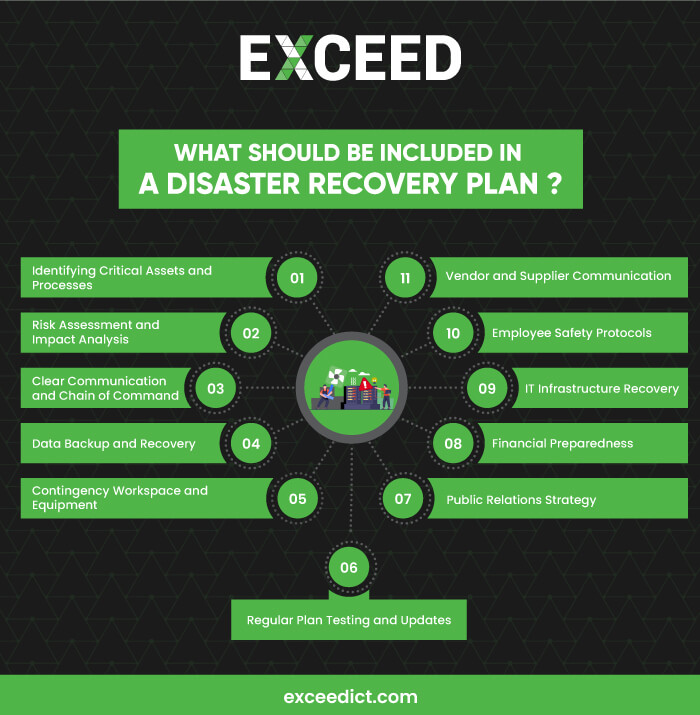
Crafting an Effective Disaster Recovery Plan
 Disasters can strike without warning, wreaking havoc on businesses and causing significant disruptions. To mitigate the impact of such events, organisations must have a robust disaster recovery plan in place.
Disasters can strike without warning, wreaking havoc on businesses and causing significant disruptions. To mitigate the impact of such events, organisations must have a robust disaster recovery plan in place.
A well-crafted disaster recovery plan outlines the procedures and strategies to follow when unexpected incidents occur, ensuring minimal downtime and data loss. In this comprehensive guide, we’ll explore the essential components that should be included in a disaster recovery plan and provide insights to help you create a resilient strategy for your business.
Building Resilience Through Comprehensive Disaster Recovery Planning
In today’s fast-paced business landscape, being prepared for the unexpected is crucial. A disaster recovery plan serves as a safety net, helping businesses navigate through unforeseen events like natural disasters, cyberattacks, equipment failures, and more.
This plan goes beyond the IT realm, encompassing all aspects of operations to ensure a seamless recovery process. By including various elements and strategies, you can fortify your business’s ability to recover swiftly and efficiently from any disaster.
What Should Be Included in a Disaster Recovery Plan?
 Identifying Critical Assets and Processes
Identifying Critical Assets and Processes
One of the first steps in creating a disaster recovery plan is identifying the critical assets, systems, and processes that are vital for your business’s operations. This includes both digital assets, such as data servers and software applications, and physical assets like machinery and equipment. By pinpointing these essentials, you can prioritise recovery efforts and allocate resources effectively.
Risk Assessment and Impact Analysis
Conducting a thorough risk assessment and impact analysis is essential to understand the potential threats your business may face. Evaluate the likelihood of each threat occurring and assess the potential damage it could cause. This analysis forms the foundation of your disaster recovery strategy, enabling you to tailor your plan to address specific risks.
Clear Communication and Chain of Command
In times of crisis, clear communication is paramount. Establish a well-defined chain of command that designates who is responsible for making decisions and coordinating recovery efforts. This prevents confusion and ensures that everyone knows their roles and responsibilities during a disaster.
Data Backup and Recovery
Data is the lifeblood of modern businesses, making data backup and recovery a critical component of any disaster recovery plan. Regularly back up your data and store copies in secure off-site locations. Implement a reliable data recovery process to restore lost information swiftly and accurately.
Contingency Workspace and Equipment
Depending on the nature of the disaster, your primary workspace may become inaccessible. Prepare a contingency workspace equipped with the necessary tools, equipment, and resources to maintain essential operations. This could be a secondary office location or remote work setups.
Vendor and Supplier Communication
Disruptions can extend beyond your organisation to include vendors and suppliers. Establish open lines of communication with these external partners and ensure they have their own disaster recovery plans in place. Collaborate on strategies to minimise supply chain disruptions.
Employee Safety Protocols
During a disaster, the safety of your employees is of utmost importance. Develop and communicate clear safety protocols to follow, including evacuation plans and procedures for on-site emergencies. Regularly conduct drills to ensure that everyone is well-prepared.
IT Infrastructure Recovery
In the digital age, IT infrastructure is integral to business operations. Outline procedures for recovering your IT systems and networks. This includes reinstalling software, reconfiguring networks, and ensuring cybersecurity measures are in place.
Financial Preparedness
Disasters can have a significant financial impact. Ensure you have financial measures in place, such as emergency funds and insurance coverage, to navigate through disruptions without jeopardising the financial stability of your business.
Public Relations Strategy
Maintaining a positive public image during and after a disaster is essential. Craft a public relations strategy that outlines how to communicate with customers, partners, and the media. Transparency and timely updates can help manage reputational damage.
Regular Plan Testing and Updates
A disaster recovery plan is only effective if it’s tested and updated regularly. Conduct mock disaster drills to evaluate the plan’s efficacy and identify areas for improvement. As your business evolves, update the plan to reflect changes in assets, processes, and risks.
Frequently Asked Questions

Q: How often should I update my disaster recovery plan?
A: It’s recommended to review and update your plan at least annually or whenever there are significant changes in your business structure, processes, or risks.
Q: Can a disaster recovery plan prevent all disruptions?
A: While a well-crafted plan can significantly mitigate disruptions, it may not prevent all disasters. It focuses on minimising downtime and ensuring a swift recovery.
Q: Is data backup sufficient for disaster recovery?
A: Data backup is a crucial part of disaster recovery, but a comprehensive plan includes various elements like communication strategies, equipment readiness, and employee safety protocols.
Q: How can I ensure employee adherence to the plan during a disaster?
A: Regular training, drills, and clear communication can help employees understand their roles and responsibilities, ensuring smoother execution of the plan during a crisis.
Q: What’s the role of senior management in disaster recovery?
A: Senior management plays a vital role in decision-making, resource allocation, and overall coordination during a disaster. Their leadership is essential for a successful recovery.
Q: Are there professional services available for creating a disaster recovery plan?
A: Yes, many consulting firms specialise in disaster recovery planning. They can help assess your business’s unique risks and develop a tailored plan.
Conclusion: Building Resilience for a Secure Future
Crafting a robust disaster recovery plan is not just about mitigating risks – it’s about safeguarding your business’s future. By considering all aspects of your operations, identifying vulnerabilities, and preparing for a variety of scenarios, you can navigate through crises with confidence. Regular testing and updates will ensure that your plan remains effective and relevant, allowing you to recover swiftly and emerge even stronger from adversity..
You may also like to know more about
- How to Create an IT Disaster Recovery Plan Steps, Strategy, and More.
- 10 Vital IT Disaster Recovery Plan Steps for Safeguarding Your Business.
- IT Disaster Recovery Plan Objectives For Safeguarding Business Continuity.
- IT Disaster Recovery Plan Example To Ensure Business Continuity.
- Comprehensive IT and Network Disaster Recovery Plan Checklist.
- Disaster recovery plan checklist template for Small business.
Stay connected with EXCEED ICT
Stay connected with EXCEED ICT by joining our social networks (given at footer). Get the latest updates, news, and tips for enterprise device deployment. Follow us on Twitter, Facebook, and LinkedIn for the best enterprise device deployment solutions.
Help us to improve our enterprise by rating us on Google Maps. Your feedback and comments are valuable to us and will be used to make our services even better.



